What is acromionclavicular (AC) joint pain?
Acromioclavicular (AC) joint injury causes pain and inflammation in the joint at the top of the shoulder. It causes pinpoint tenderness and pain and is aggravated by bringing your arm across your body and above your head, especially with weight. It mainly affects those who lift weights in the gym and following a fall onto the outside of the shoulder i.e., falling off your bike. Acromioclavicular joint injuries do not always settle with conservative management. Physiotherapy and ultrasound guided steroid injections are effective treatment modalities.
What are the symptoms of acromioclavicular (AC) joint pain?
The symptoms of acromioclavicular (AC) joint injury are:
- Pain located on the top of your shoulder with tenderness when you touch the joint
- Pain lying on your side
- Pain if you move your arm across the midline of your body and above shoulder level
If this sounds like your pain, read on below…
What other conditions can mimic acromioclavicular (AC) joint pain?
If this does not sound like your pain, there are other conditions that can mimic the pain of acromioclavicular joint pain such as:
- shoulder joint osteoarthritis
- frozen shoulder
- shoulder impingement
- rotator cuff pain
- subacromial bursitis
Acromioclavicular (AC) joint pain vs shoulder osteoarthritis (OA)?
Acromioclavicular (AC) joint injury presents with pain on the top of the shoulder (above the arm) and tenderness when you touch the joint on the point of the shoulder. Whereas shoulder joint osteoarthritis (OA) does not cause such local pinpoint tenderness. Both conditions are characterised by pain caused by movements above the head, but acromioclavicular (AC) joint pain is specifically aggravated by movement across the midline of the body e.g., moving your arm across your neck.
The anatomy
The acromioclavicular Joint (also known as the ACJ) is a small, robust joint located at the top of the shoulder. It is located between the acromion (part of the scapular bone) and the clavicle (collar bone) (see image below). The AC joint plays a critical role in the position of the shoulder blade and the shoulder girdle during arm movements (Mall et al.,2013). It is therefore, routinely placed under high levels of stress during activities of daily living, including work and sporting activities.
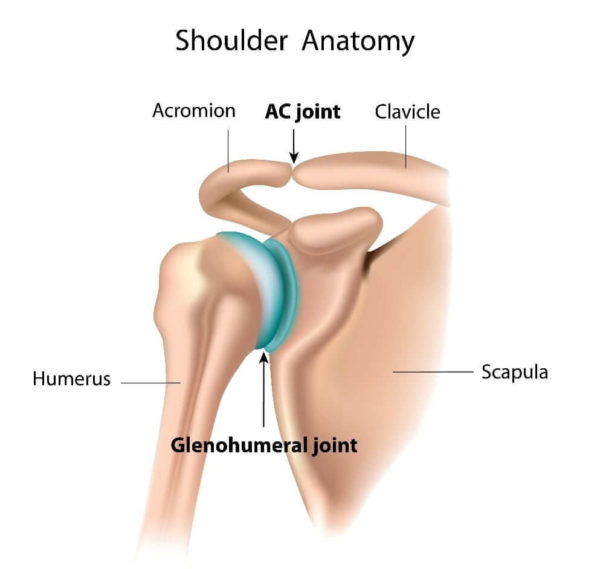
The ACJ is a common site for shoulder pain. Mazzocca et al., (2007) observed the acromioclavicular joint to be involved in 9% of all shoulder girdle injuries. This study also showed the ACJ to be responsible for 43.5% of all shoulder injuries in patients in their 20s. Interestingly research by Mall et al. (2013) revealed that the ACJ develops slowly and does not complete ossification until, on average the 25th year of life.
The ACJ is a common site for shoulder pain. Mazzocca et al., (2007) observed the acromioclavicular joint to be involved in 9% of all shoulder girdle injuries. This study also showed the ACJ to be responsible for 43.5% of all shoulder injuries in patients in their 20s. Interestingly research by Mall et al. (2013) revealed that the ACJ develops slowly and does not complete ossification until, on average the 25th year of life.
Cadogan et al., (2013) states that ACJ pain can occur for a variety of reasons. These risk factors include:
- Trauma – injury of the shoulder including fractures dislocations and ligament ruptures are associated with the onset of ACJ pain. ACJ trauma commonly occurs after sustaining a fall onto the point/side of the shoulder. Trauma can cause damage to the joint capsule and ligamentous structure of the ACJ which can result in joint instability.
- ACJ osteoarthritis risk increases with age. Most cases of ACJ osteoarthritis occur in in the fifth decade of life onwards. The onset of ACJ osteoarthritis before the age of 50, is often associated with injury/trauma.
- Occupation – jobs involving repetitive shoulder movements or operating heavy machinery can cause increased stresses on the shoulder joint. Repetitive movements or heavy loading of the shoulder can cause osteoarthritis.
- Overhead activities such as racquet or throwing sports and weightlifting are commonly associated with the development of ACJ osteoarthritis.
- Rheumatoid arthritis or other inflammatory conditions can cause ACJ pain.
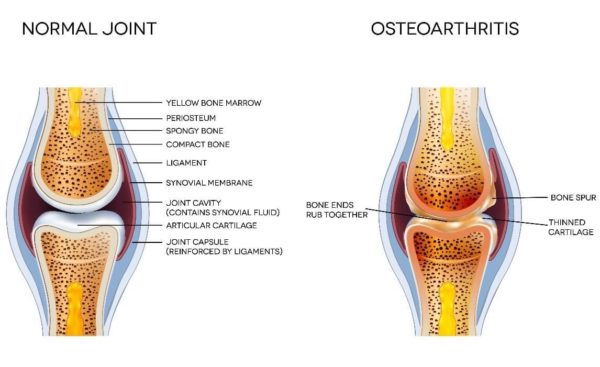
How do you know if you have an ACJ dysfunction?
Symptoms of ACJ pain commonly start with pain at the top of the shoulder. This is often made worse when completing overhead activities or crossing the arm over the body. As ACJ dysfunction or osteoarthritis develops, symptoms become progressively painful and more frequent. This may result in constant pain during activities of daily living and may wake patients at night.

Patients with acromioclavicular joint pain, often have difficulty when moving their arm above shoulder level, and in particular stretching their arm across their body is very painful (see above image). It is often painful to touch the area and patients experience pain lying on the affected side at night.
Symptoms may start after a fall onto the shoulder. This can result in a disruption of the joint, sometimes called an ACJ separation or sprain and may cause a ‘step’ or a ‘bump’ on the top of the shoulder.
How is acromioclavicular joint pain diagnosed?
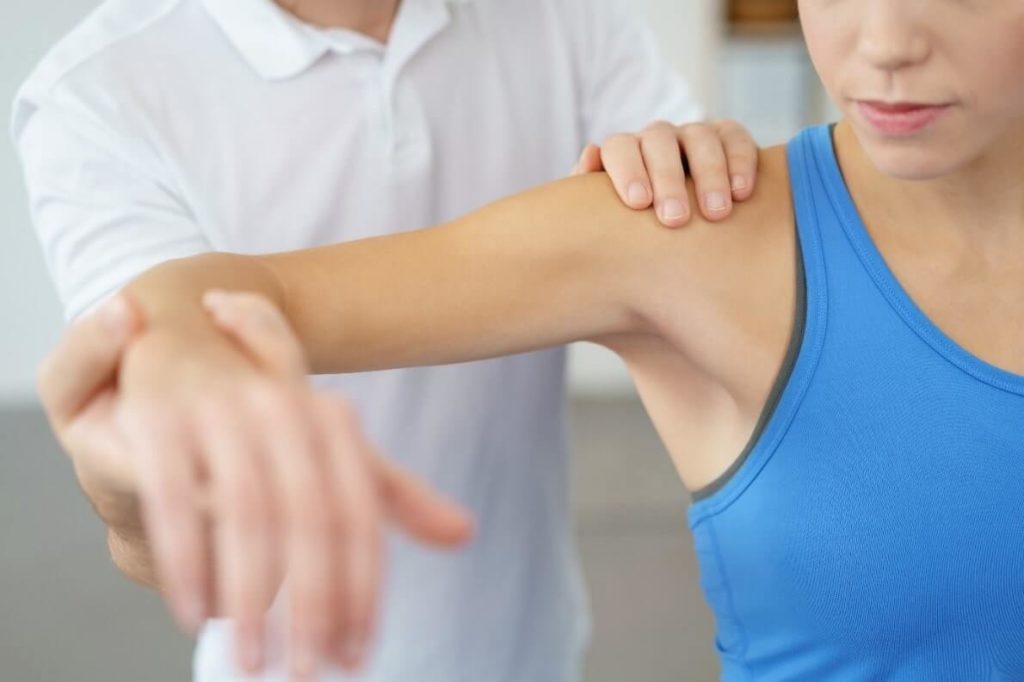
A diagnosis of ACJ pathology can be made by one of our expert clinicians. The assessing clinician will initially ask a series of questions to uncover how and why your pain started. They may also ask you a series of questions concerning your medical history to assess for any medical conditions which may be involved in the onset of your pain. After your consultation, the clinician will complete a sequence of tests to help develop a hypothesis of ACJ pathology. Research conducted by Cadogan et al., (2013) revealed clinical testing alone is a useful diagnostic tool, but for a complete and full diagnosis diagnostic imaging is required.
If your clinician is unsure of your diagnosis that they may refer you for an x-ray, blood tests or diagnostic ultrasound imaging. These will be discussed below;
X-ray
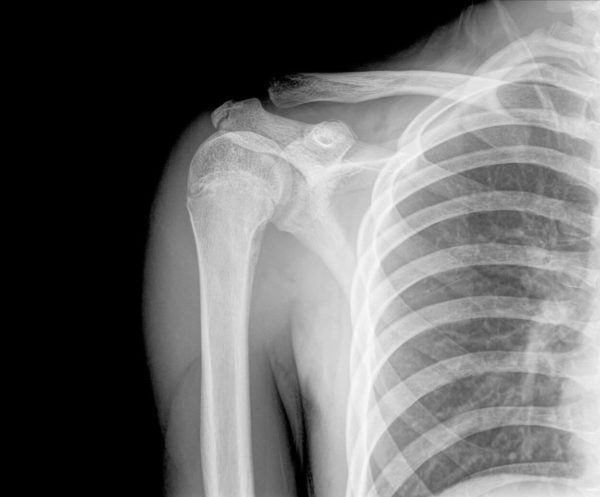
Plain x-ray imaging is the gold standard imaging for assessing both of bone and joint pathology. It is excellent for diagnosing fractures and the presence of osteoarthritis.
Blood tests
If your clinician believes your symptoms may have started due to a systemic inflammatory condition such as rheumatoid arthritis and may refer you for a series of blood tests. This is routinely completed via your GP.
Diagnostic ultrasound imaging has been shown to be as effective as MRI for assessing ACJ pathology, including both osteoarthritis/degenerative changes and the presence of trauma as well as the presence of swelling and inflammation often associated with ACJ pathology (European Society of Musculoskeletal Radiology., 2018). Diagnostic ultrasound scan can also assess the ACJ during arm movements, allowing the clinician to observe the joint during painful activities.
Complete has a highly skilled team of experienced physiotherapists who are duul qualified musculoskeletal sonographers. On assessment your clinician will use a combination of clinical tests and carry out a musculoskeletal ultrasound scan to provide an accurate diagnosis. If you would like more information or would like to book an appointment please contact us on 0207 4823875 or email injections@complete-physio.co.uk.
How do we treat acromioclavicular joint pain?
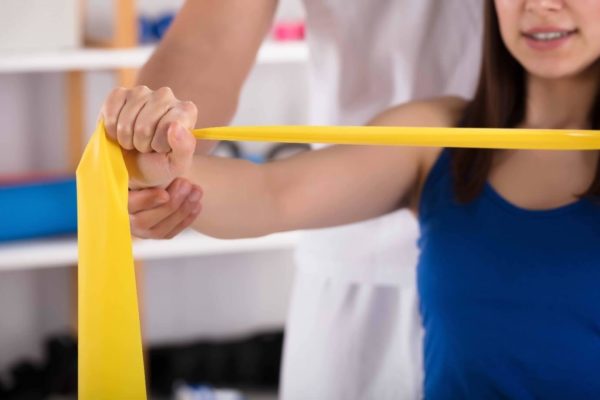
In general, acromioclavicular joint pain can be well managed with a course of physiotherapy, over-the-counter medication and a short period of rest from aggravating factors. Physiotherapy often involves a combination of corrective strengthening and stretching rehabilitation exercises, manual techniques including soft tissue release and postural advice.
Want if conservative management does not work?
In cases where conservative management, including physiotherapy and rehabilitation, are unsuccessful and your symptoms persist, an ultrasound guided steroid injection may be appropriate for you.
Before considering a steroid injection we would advise that you have completed follow these steps:
- Rest from aggravating movements and exercises, for example avoid overhead exercises in the gym
- Local ice massage or anti-inflammatory creams – the joint is very superficial so topical medication may be helpful onto the painful area (speak to a pharmacist)
- Physiotherapy to reduce pain, restore normal joint movement and muscle strength. This may also involve sports taping – to reduce the pressure on the joint.
Steroid injections are very effective for all types of shoulder pain including the acromioclavicular joint pain when placed directly into the joint under ultrasound guidance. Steroid is a strong anti-inflammatory that can significantly reduce the joint pain. This procedure is well supported in the medical literature.
Ultrasound guidance has been shown in the evidence base to be significantly more accurate than landmark based injections for the acromioclavicular joint (100% accuracy versus 35% respectively) (Daniels et al, 2018, Aly et al., 2015). This injection technique involves guiding the needle directly into the joint under guidance using an ultrasound scanner. Research has also shown reduced post injection complications and significantly quicker pain relief when using this technique.
At Complete advise steroid injections for acromioclavicular joint pain, if it has been there for over 6 weeks and is not improving with a course of physiotherapy. However, if you have sustained a separation from a fall onto the shoulder then we normally advise waiting a little longer as steroid can reduce your natural healing mechanisms. Separation type injuries often take a little longer to improve depending on the severity of the separation.
How many injections do you need?
Most of our patients only require one injection. Our article on ‘how many steroid injections can I have?’ provides further information. One injection normally provides the pain relief required and provides a window of opportunity to focus on restoring your full range of movement and function of the shoulder. Occasionally, in cases of known osteoarthritis or if the joint is very inflammed, more than one injection may be required.
An assessment at Complete includes both clinical testing and a diagnostic ultrasound scan. This allows for a highly specific and accurate diagnosis and therefore effective treatment. If appropriate, your clinician will be able to advise and prescribe the most effective medication for you prior to performing an ultrasound guided injection. Complete provide a same-day service on all guided injections with no need for referral from a consultant or a GP.
If you would like more information or would like to book an appointment please contact us on 0207 4823875 or email injections@complete-physio.co.uk.


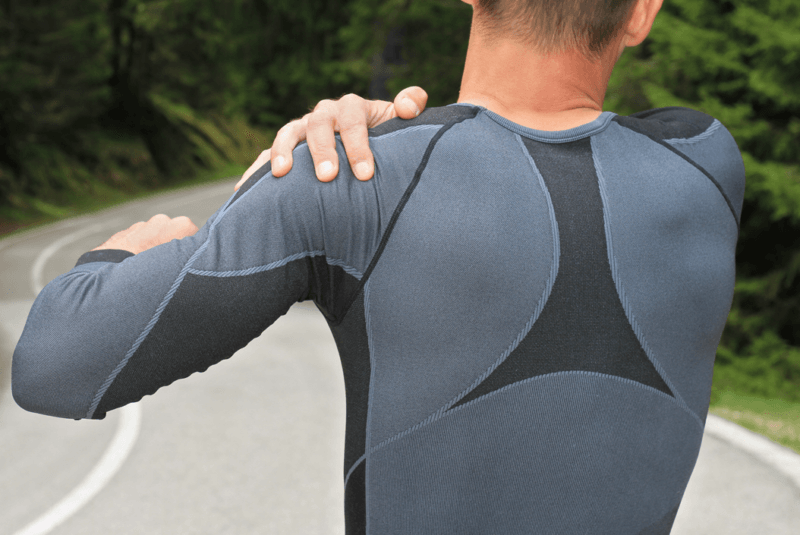
Leave A Comment